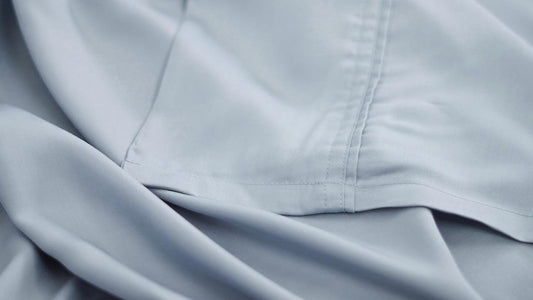While cleaning your home textiles is necessary to ensure the cleanliness and hygiene of your home, washing a duvet isn’t exactly the most fun spring cleaning activity. After all, it’s cumbersome, often delicate, and the guidelines on how to wash a duvet can differ depending on the brand of your duvet and its size.
But there has to be a simple rule-of-thumb when it comes to washing duvets, right? In the following guide, we’re going to talk you through how to wash a duvet, and answer some commonly-posed questions on washing, drying, and storing your duvet and duvet covers after a clean. Let’s take a look.
Why Cleaning Your Duvet Is Important
So, why is cleaning your duvet so important? Firstly, it’s simply a question of hygiene; even if your duvet is covered with a queen size duvet cover, it can still end up being a breeding ground for bacteria, sweat, dead skin, fungus, and moisture - especially if the cover isn’t fully closed at the bottom. Not washing your duvet can allow these germs and bacteria to thrive, multiply, and eventually transfer to you, potentially causing infections, rashes or other irritations.
Secondly, dust and dust mites can gather and thrive inside duvet covers, as humid, dark places are ideal for these mites to live, breed and die, but at a cost to you; dust mites can trigger allergies and cause hives, rashes, and in more serious cases, asthma attacks.
How to Clean a Duvet
So, how do you clean a duvet? Here’s our step-by-step guide:
Tackle Stains First
Whether it be coffee stains or ink stains, you’ll first want to spot-treat any marks you have on your duvet before washing it. Use an appropriate stain remover to lift these, while also using this time to ensure there are no holes or tears in the duvet itself; if you do find tears, you might want to hold off on washing your duvet - the fibres could spill through any holes during the wash, creating something of a mess (and a ruined duvet!).
Remove the Duvet Cover
You can’t wash a duvet with the cover still on, so make sure you remove this before putting your duvet in the machine.
Place Duvet into the Washing Machine
Before washing your duvet, consider the duvet cover size. After all, cleaning a duvet is all about ensuring adequate space for the duvet to move around in the machine, as this ensures that every inch of the duvet is washed. If you find yourself struggling to fit your duvet into your home washing machine, consider taking it to a dry cleaner’s instead, where you’ll be able to use a larger machine; the same goes for a king duvet cover and any other larger bedding items you may have.
Note: For king and queen sized duvets, you’re better off opting to wash the duvet in a larger, extra-capacity front-loading washer at the dry cleaner’s.
Add Detergent
Once your duvet is comfortably in the washing machine, it’s time to add detergent. Note that you should wash a duvet on its own for the best results, so you only need to add half the recommended dose of detergent to the machine. Opt for a gentle detergent, avoiding harsher bleaches as well as fabric softeners.
Launch the Cycle
Once the detergent is in, launch a gentle cycle with warm water. As duvets can be absorbent and take longer to rinse out any product, you should also add an extra rinse and spin if your machine has that option. After the cycle is finished, take out your duvet and check for suds - if you see any lingering soap residue, launch another wash cycle again, this time without detergent.
Transfer to Dryer
Once your duvet is sud-free, take care as you move it to a large dryer, before putting it on a low setting to dry. If you’re using your home washing machine and you have a garden, you can also let it air dry - just make sure it’s not going to rain!
If you’re using a dryer, you should also make sure to check the duvet from time to time to ensure there’s an even distribution of fluff - you can remove it from the machine and hand-fluff it yourself if it appears uneven.
Remember that duvets are heavy-duty and can take some time to dry - anywhere between a few hours to half a day, depending on whether you’re air-drying it or using a machine - but don’t rush the process along. Storing away your duvet (or putting it back on your bed) while it’s still damp in some areas can cause mildew, so ensure it’s fully dry before taking it out of the machine or the garden.
FAQs
Can you wash duvet with cover on?
No - washing a duvet with the cover still on is counter-productive, and will prevent the duvet from being cleaned thoroughly. Clean your duvet first (as it takes the longest) then clean your duvet cover, pillow cases and other bedding as your duvet dries.
Can you wash a duvet insert?
Yes! Cleaning your duvet insert is essential to ensure optimal bed hygiene - duvet inserts harbour bacteria, dust and moisture, so regular cleaning is essential to prevent irritation, infection, and nasty odours.
How often should I wash my duvet?
Ideally, you should wash your duvet (or duvet insert) at least once every year, and wash your other bedding (pillow cases and duvet covers) every 2 weeks.






